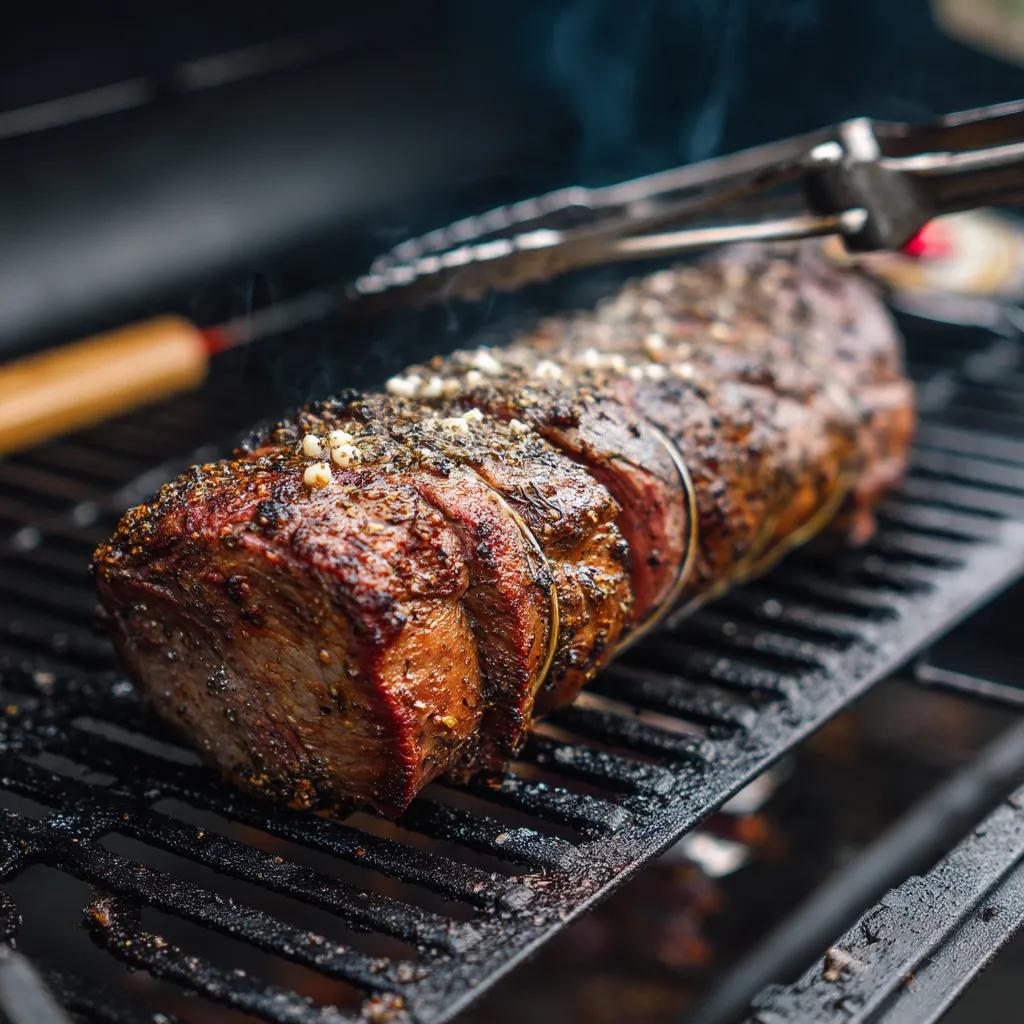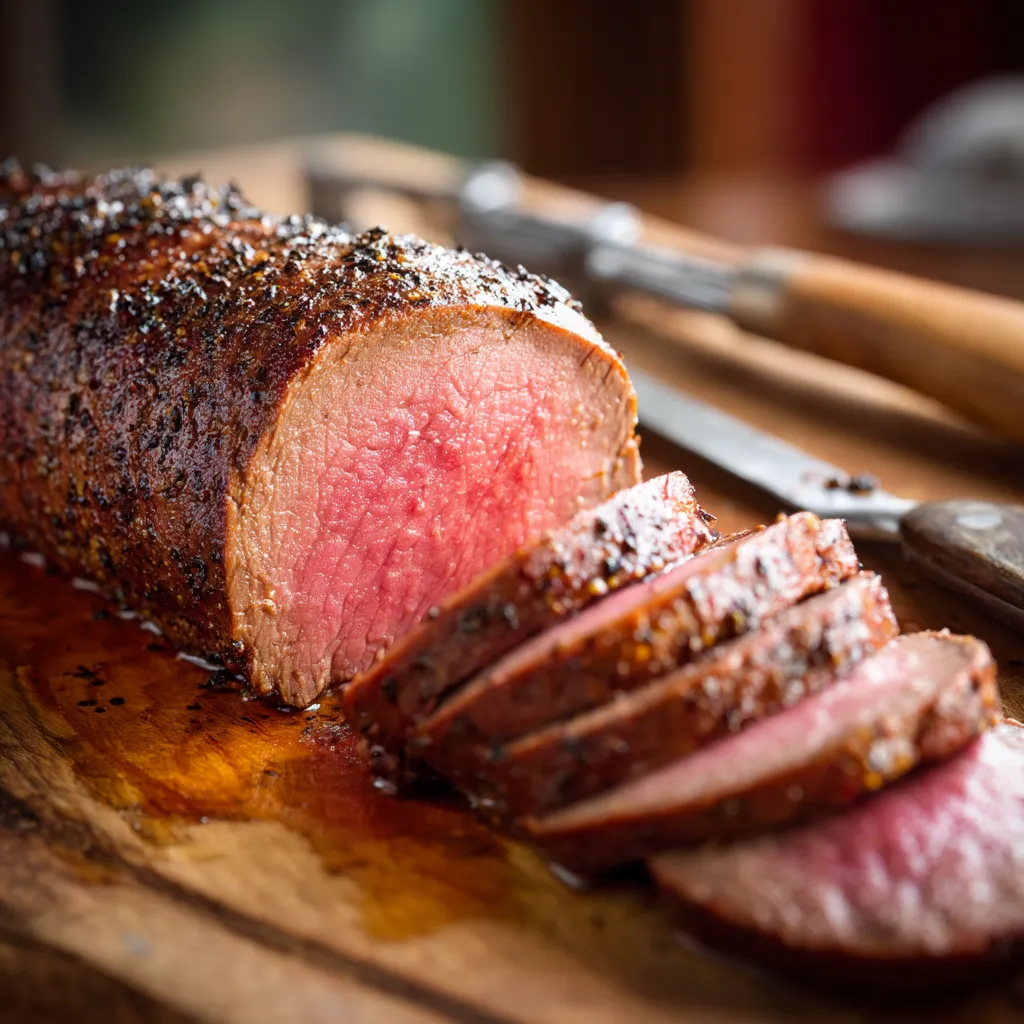 Save to Pinterest
Save to Pinterest This luxurious smoked beef tenderloin transforms an already special cut into something truly extraordinary. The gentle kiss of smoke enhances the meat's natural flavors while maintaining that buttery-soft texture that makes tenderloin so coveted. I've perfected this method over years of holiday gatherings where it consistently steals the spotlight.
I first prepared this for my father-in-law's birthday celebration after he mentioned missing authentic steakhouse dinners during the pandemic. The look on his face when he took that first perfectly pink, smoky bite made it my signature special occasion dish.
Ingredients
- 4 pound beef tenderloin trimmed and tied. Splurge on quality here the marbling and tenderness make all the difference
- 2 tablespoons coarse salt. The larger crystals create a beautiful crust
- 1 tablespoon coarse black pepper. Freshly cracked provides more aromatic oils
- 1 tablespoon granulated garlic. Adds depth without overpowering the beef flavor
Step-by-Step Instructions
- Prep the Tenderloin
- Begin by removing any excess fat and silver skin from your tenderloin. This tough connective tissue won't break down during cooking and can cause the meat to curl. Fold the thinner tail end underneath and secure the entire roast with butcher twine at 2 inch intervals. This creates an even thickness throughout ensuring consistent doneness from end to end.
- Season Thoroughly
- Combine your salt pepper and garlic in a small bowl mixing well to distribute evenly. Apply the seasoning mixture generously over the entire surface of the tenderloin pressing it gently to adhere. The coarse texture of the salt and pepper will create a magnificent crust during the smoking and searing process.
- Smoke with Patience
- Preheat your smoker to exactly 225°F. Place the seasoned tenderloin directly on the grates and close the lid. Allow it to smoke undisturbed until the internal temperature reaches 120°F for medium rare measuring at the thickest part. This typically takes between 90 and 120 minutes depending on your specific smoker and the exact thickness of your roast.
- Sear for the Finish
- While the tenderloin is nearing target temperature preheat your grill to approximately 450°F. Transfer the smoked tenderloin to the hot grill and sear each side for 3 to 4 minutes rotating with tongs to develop an even crust. Monitor the internal temperature closely removing the meat when it reaches between 135°F and 139°F as it will continue cooking during rest.
- Rest and Serve
- Loosely tent the finished tenderloin with foil and allow it to rest undisturbed for a full 15 minutes. This critical step allows the juices to redistribute throughout the meat. After resting slice into generous portions between 1 and 1½ inches thick. The center should display a perfect rosy medium rare with a deep smoky crust.
 Save to Pinterest
Save to Pinterest The granulated garlic in this recipe is my secret weapon. Unlike garlic powder it provides a more robust flavor that stands up to the smoking process without becoming bitter. My family gathering last Christmas featured this tenderloin and my brother actually called me the next day asking for the recipe the highest compliment a home cook can receive.
Wood Selection Matters
The type of wood you choose significantly impacts the final flavor profile of your smoked tenderloin. I prefer a combination of cherry and oak chips when smoking beef. Cherry imparts a subtle sweetness and beautiful color to the meat while oak provides that classic smoky backbone without overpowering the beef's natural flavors. Avoid stronger woods like mesquite which can easily dominate the delicate tenderloin. If you only have access to one wood variety cherry makes an excellent standalone choice.
Temperature Guide for Perfect Doneness
Understanding your target temperatures ensures perfect results every time. For rare tenderloin aim for a final temperature of 125°F after resting. Medium rare which most guests prefer falls between 135°F and 140°F. Medium doneness registers at 145°F though I personally find this begins to sacrifice the buttery texture tenderloin is known for. Always remember that carryover cooking during rest will increase internal temperature by approximately 5°F so remove the meat from heat slightly before reaching your target temperature.
Serving Suggestions
Elevate your smoked tenderloin with thoughtfully paired sides and sauces. A horseradish cream provides traditional steakhouse appeal simply combine prepared horseradish with sour cream and a touch of lemon juice. For something more complex a mushroom bourbon sauce complements the smokiness beautifully. As for sides roasted fingerling potatoes and grilled asparagus maintain the elegant simplicity while adding color and texture to the plate. Thinly sliced leftovers make exceptional sandwiches the next day served on crusty bread with arugula and a touch of highquality mayonnaise.
Preparing Ahead for Stress Free Entertaining
You can season the tenderloin up to 24 hours before smoking allowing the salt to penetrate deeply into the meat. Store it uncovered in your refrigerator on a wire rack set over a baking sheet. This dry brining technique enhances flavor and helps develop a beautiful crust. The tenderloin can also be smoked several hours before serving. After smoking wrap it tightly in foil and hold at room temperature for up to 2 hours. When ready to serve simply complete the searing step to bring it back to temperature. This approach frees you to enjoy time with guests while still presenting a perfectly cooked centerpiece.
 Save to Pinterest
Save to Pinterest Common Recipe Questions
- → How do I know when my beef tenderloin is perfectly cooked?
For medium-rare tenderloin, remove from the smoker when internal temperature reaches 120°F, then sear until it reaches 135-139°F. After resting, it will reach the ideal 145°F. Always use a reliable meat thermometer inserted into the thickest part for accuracy.
- → Why is it important to tie the tenderloin before smoking?
Tying the tenderloin with butcher twine creates a uniform shape that ensures even cooking throughout. It also helps tuck the thinner tail end underneath, preventing overcooking of that section while the thicker portions reach proper temperature.
- → What wood works best for smoking beef tenderloin?
Oak, cherry, and hickory woods complement beef tenderloin beautifully. Oak provides classic smoky flavor, cherry adds mild sweetness and color, while hickory delivers a stronger, bacon-like smoke profile. For a milder option, try pecan or apple wood.
- → Can I prepare the tenderloin in advance?
You can trim, tie, and season the tenderloin up to 24 hours in advance. Store covered in the refrigerator, then bring to room temperature for 1 hour before smoking. This extra time allows the seasoning to penetrate deeper into the meat.
- → Why is the two-step cooking process (smoking then searing) recommended?
This reverse-sear method allows the tenderloin to absorb maximum smoke flavor during the low-temperature smoking phase while maintaining its moisture. The high-heat sear at the end creates a flavorful crust without overcooking the center, resulting in perfect edge-to-edge doneness.
- → What are the best sauces to serve with smoked beef tenderloin?
Classic accompaniments include chimichurri, horseradish cream, or red wine reduction. A compound butter with herbs like rosemary and thyme also complements the smoky flavors beautifully. For something simpler, a high-quality finishing salt enhances the natural flavors.